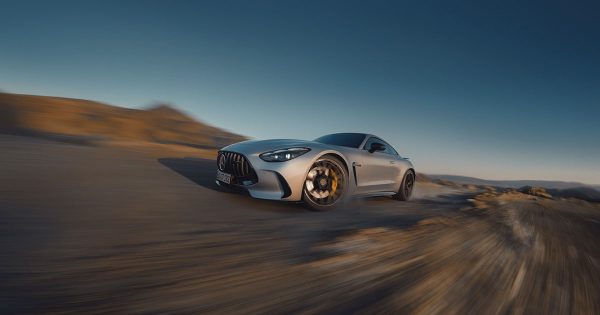The Mercedes-Benz Vision One-Eleven: Inspired by the 70s

Mercedes-Benz has unveiled a new sports car concept: The Vision One-Eleven combines a highly dynamic design language with innovative all-electric powertrain technology. The supercar silhouette is characterized by skilful execution of the signature Mercedes-Benz One-Bow design that is a marker of its 21st-century style. Its technical highlights include the extremely powerful and highly efficient axial-flux motor developed by electric motor specialist YASA, Mercedes-Benz division.
The Mercedes-Benz Vision One-Eleven: Reminiscent of the iconic C111
If the Mercedes-Benz Vision One-Eleven reminds you of something, it’s that it’s inspired by the tradition of the legendary C 111 experimental vehicles from the 1960s and ’70s, which were used to test revolutionary Wankel and turbodiesel engines. They were also prototypes for testing polymer-based bodyshells. The extremely (aero) dynamic mid-engine sports cars are considered design icons of their era, not least due to their distinctive gullwing doors and eye-catching orange-and-black paintwork.

Gorden Wagener, Chief Design Officer, Mercedes-Benz Group AG and Markus Schäfer, Chief Technological Officer of Mercedes-Benz with the Mercedes-Benz Vision One-Eleven
Photo : Mercedes-Benz
“Our goal at Mercedes-Benz is not to do styling—our goal is to create icons. To me, that makes the difference between mainstream design and luxury. Design icons like the Type 300 SL and C 111—both with gullwing doors—are part of our DNA. These legendary vehicles were major inspirations for the iconic design of the Mercedes-Benz Vision One-Eleven. This is beauty and the extraordinary united in one vision of the future. Our all-electric vision show car is the modern-day interpretation of the C 111, which was avant-garde at the time. The element of surprise comes from its exceptionally clean, purist and, at the same time, extremely muscular proportions. This iconic clarity is also reflected in the interior. The equally sensual but minimalist design language stands for ICONIC LUXURY by Mercedes-Benz.”
– Gorden Wagener, Chief Design Officer, Mercedes-Benz Group AG
The exterior of the Mercedes-Benz Vision One-Eleven—One-Bow design in its most athletic form
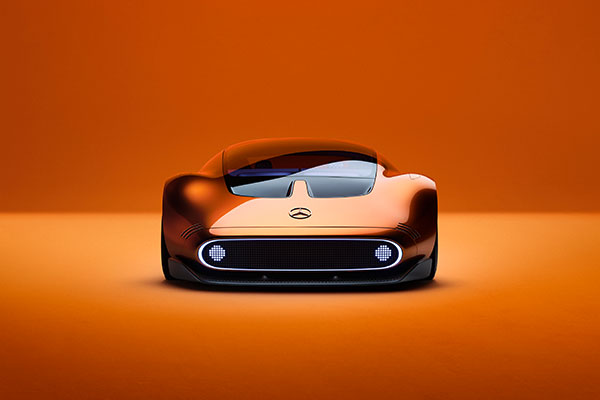
The Mercedes-Benz Vision One-Eleven
Photo: Mercedes-Benz
The body of the Mercedes-Benz Vision One-Eleven centres on skilful execution of the One-Bow design. From the low-slung front end to the muscular hind quarters, it runs in a smooth bow that endows the just 1,170 mm-high vehicle silhouette with an extremely sculptural feel. This harmonizes perfectly with the copper-orange alubeam paintwork. It provides an unmistakeable reference to the distinctive colour of the C 111 without adopting it one-to-one. The colour of the Mercedes-Benz Vision One-Eleven is considerably more powerful than that of the C 111 and also changes with the light. It conveys not only a sense of quality but also a certain extravagance.
Further notable features of the side view include the flush-fit gullwing doors and the side windows, that reminds us the 300 SL, which are opaque from the outside and camouflaged by a pixelated pattern. Yet another is the large-diameter wheels inserted seamlessly into the wheel arches beneath voluminous flared wings. This reinforces the impression of an uncompromisingly sporty and aerodynamically refined driving machine. The wheel design incorporates powerfully structured elements evocative of electric motor windings—a clear indicator of the state-of-the-art, all-electric powertrain underpinning the Mercedes-Benz Vision One-Eleven. They stand in spirited contrast to the vehicle’s iconic, minimalist and smooth surface design, which is more akin to a sculptural art piece. This contrast is typical of the X-factors the brand applies to its design thinking and a distinctive feature of the Vision One-Eleven.
Another striking contrast arises through the very low-slung front and rear skirts finished in matte black. The two deeply scooped aerodynamic elements are visually connected by two blade profiles in the same colour running along the flanks beneath the sills. These profiles feature piercings that are backlit in blue. The functional aerodynamic elements also serve as a further design reference to the C 111, which is painted black on the lower portion of its bodyshell. The dark “keel line” of the Mercedes-Benz Vision One-Eleven generates an impression of seamless transition between the vehicle and the ground beneath it that is even more powerful than that of the C 111. The form of the car appears fused with the road surface.
The front-end design—iconic high-tech look with historical reference
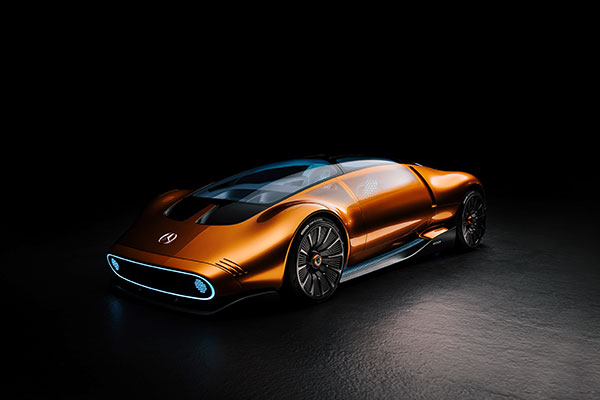
The Mercedes-Benz Vision One-Eleven
Photo: Mercedes-Benz
From the frontal aspect, too, the Mercedes-Benz Vision One-Eleven is powerfully evocative of the C 111. In detail, however, there are striking differences: One standout example is the distinctive front end, which on both vehicles consists of a low-lying rectangular element with rounded ends left and right. On the C 111, this is a closed plastic element with a honeycomb structure, fitted with round fog lamps. The corresponding part on the Vision One-Eleven appears very similar at first glance. However, upon closer inspection, it reveals itself as a high-tech feature. The panel is a flexible external display with a 3D pixelated look. It interprets the C 111’s characteristic round lights in digitized form and can also convey messages to other road users.
In contrast to the C 111, the Mercedes-Benz Vision One-Eleven bears a U-shaped and strongly profiled front apron. Above the slender light band, both forefather and descendant show further similarities, most notably the black air intakes on the bonnet.
The rear-end design—aerodynamic features and digital elements
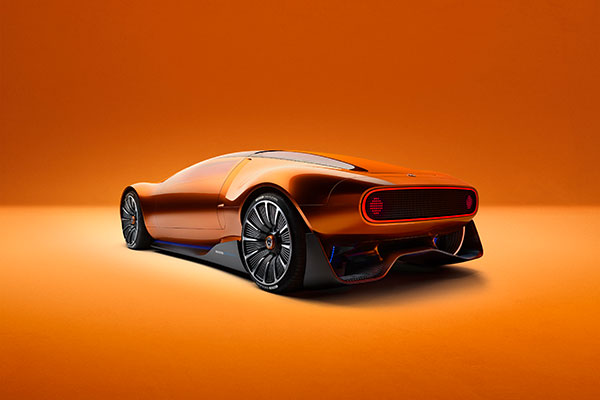
The Mercedes-Benz Vision One-Eleven
Photo: Mercedes-Benz
The rear-end of the Mercedes-Benz Vision One-Eleven is likewise dominated by a powerfully profiled diffuser. Spanning the breadth above it is a display that echoes the shape of its counterpart at the front end and features the same pixelated structure in the red taillights. Similar to the blade profiles along the sides, blue lighting effects are also visible at the rear. The inner face of the wheels is fitted with circular lighting elements.
The interior design of the Mercedes-Benz Vision One-Eleven—first sports car interior with a lounge concept
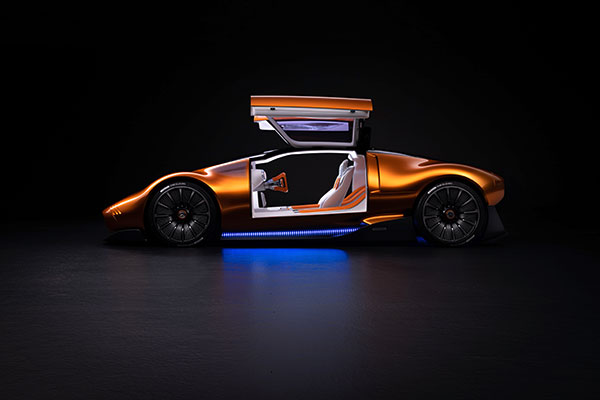
The Mercedes-Benz Vision One-Eleven
Photo: Mercedes-Benz
Inside, the Mercedes-Benz Vision One-Eleven presents the first sports car interior with a lounge concept. It reflects the paradigm shift from self-driven sports car to autonomous electric vehicle within the super sportscar segment and unites two completely different states of being. In race mode with the backrest upright and the compact driver-oriented touchscreen, the interior becomes that of a minimalist driving machine. Conversely, in lounge mode, the seats are fully integrated into the interior sculpture, which merges sills, centre tunnel and luggage compartment into a single unit.
This creates a whole new, exceptionally airy spatial concept. In contrast to previous mid-engine sports cars, it takes advantage of the compact proportions of electric motors to extend the interior rearwards. Consequently, the lounge-like interior invites occupants to take their time and relax – a completely new approach for the sports car of the future.
Futuristic and luxurious ambience with contrasting colours
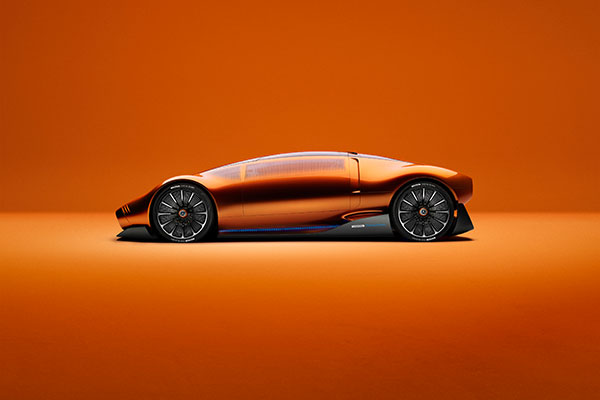
The Mercedes-Benz Vision One-Eleven
Photo: Mercedes-Benz
The interior design of the Vision One-Eleven reflects future luxury based on a progressive colour concept and extraordinary material combinations. The richly contrasting colours and materials attract attention at first glance: Large surfaces such as the dashboard are upholstered in white fabric displaying a tech-look honeycomb structure. The material is made from 100-percent recycled polyester. Other elements such as the armrests on the sills and centre console, as well as the rear parcel shelf beneath the expansive rear windscreen, are clad in bright orange leather. This creates a smooth transition from interior to luggage compartment. The sustainably processed leather was tanned using coffee bean husks. Polished aluminum in the steering-wheel spokes and inlaid as straps across the armrests underscore the tech look and feel. The same applies to the brake and accelerator pedals, both of which are made from polished aluminum and floor mounted.
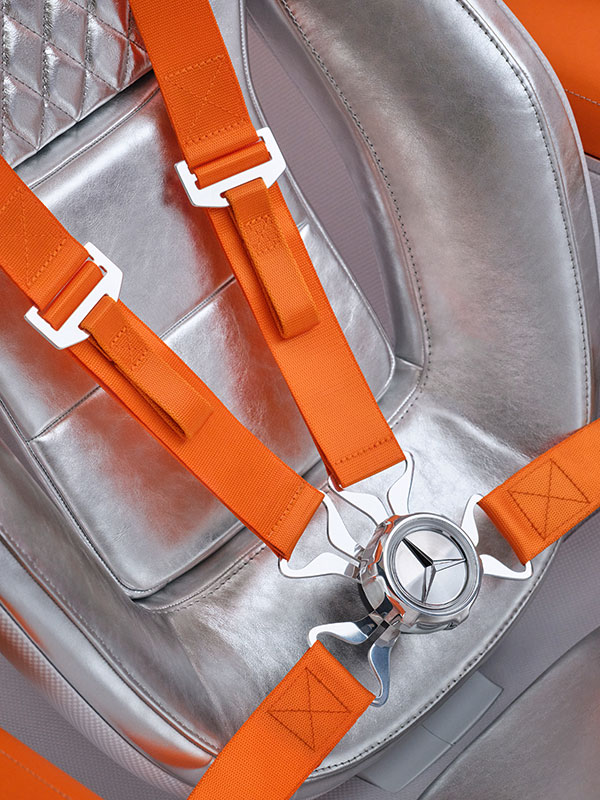
The seatbelt of the Mercedes-Benz Vision One-Eleven
Otherwise, the interior equipment in the Mercedes-Benz Vision One-Eleven has been reduced to a minimum. Like the exterior, the task here too was to keep the number of add-on features to a bare minimum. The seats are good examples as they don’t follow the classic format. Instead, the seat cushions are integrated flush-fit into the floor. This creates the initial impression of the bucket seat in a Formula 1 race car. The orange four-point harness and its high-gloss polished buckle further reinforce the sporting character.
Nevertheless, the innovative seats combine this sporting feel with luxurious comfort because, unlike in a Formula 1 race car, the angle of the backrest can be adjusted. The silver shimmer of their diamond-quilted upholstery is another eyecatcher that underscores the first-class interior ambience. Between the seats is a compact centre console, freestanding in space like a work of art.
The only highly complex feature in the interior is the leather-clad steering wheel, which is fitted with various functional controls and state-of-the-art touch elements. This is complemented by a compact touchscreen with high-resolution display mounted to the side of the steering wheel and angled towards the driver. It shows all relevant vehicle information as required.
Fusion of analogue and digital—UI/UX with retrofuturistic pixel look

The interior of the Mercedes-Benz Vision One-Eleven
Photo: Mercedes-Benz
The contrast to the modern interior is provided by the slender pixel display spanning the entire breadth of the dashboard, picking up on the form of the front and rear light bands. Here too, the pixel structure is intentionally coarse, which gives the information displayed—such as the current speed—a strikingly bold appearance. Moreover, the 3D pixel display shows digital art pieces as a coarsely rasterized stream of QR codes in the style of “early digital” news tickers. This is done with the help of glass pixels that show a changing colour gradient depending on the viewing angle. The corresponding real image then appears razor sharp on the high-resolution screen next to the steering wheel.
This combination of vastly differing representations of the same image embodies a further interpretation of the MBUX Hyperscreen with a focus on flexible interfaces. The retrofuturistic, 8-bit look thus creates an additional X-factor. The development in the Mercedes-Benz Vision One-Eleven reinforces the increasing fusion of physical and digital.
Innovative electric powertrain—high-performance axial-flux motor and all-new battery technology
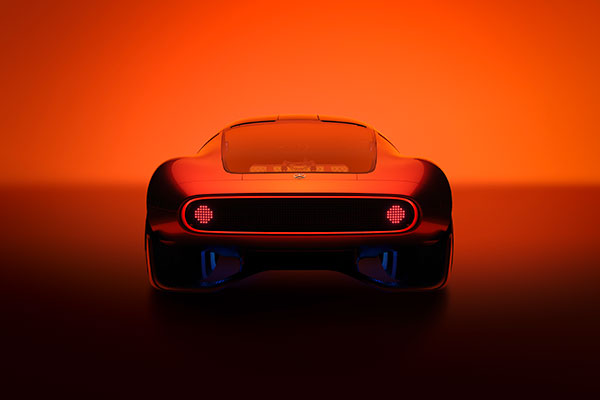
The Mercedes-Benz Vision One-Eleven
Photo: Mercedes-Benz
Technology highlights include a new battery concept featuring high-performance liquid-cooled cylindrical cells with a novel cell chemistry. Once more, the extensive knowledge of the motorsport experts from Mercedes-AMG High Performance Powertrain in Brixworth found its way into this promising concept for future performance-oriented batteries. Aside from that, the Vision One-Eleven features two exceptionally powerful and advanced axial-flux motors from YASA. Mercedes-Benz is developing this technology together with YASA to large-scale production maturity for its next-generation electric drives.
Alongside its power and torque density, another major benefit is the narrow package, which reduces both its weight and dimensions. The weight of an axial-flux motor is just one third of that of current electric motors with the same power output. At the same time, it requires just one third of the space occupied by a radial-flux motor. This opens up completely new options for engineers as well as new freedoms in the design of an electric vehicle as demonstrated by the Vision One-Eleven.
High-quality products from the Mercedes-Benz Collection: The “LIMITED EDITION 1 OF 111”
Together with the presentation of the sports car study, Mercedes-Benz is launching the “LIMITED EDITION 1 OF 111” collection. For the first time, an iconic design study is accompanied by an exclusive lifestyle collection. This translates the zeitgeist of the 1970s into the here and now, and combines casual sportiness with lavish attention to detail. In addition to the distinctive colouring of the Vision One-Eleven, the individual accessories also invoke the vehicle’s hallmark design elements. The five articles are each limited to 111 pieces and thus offer admirers of this fascinating study an exclusive opportunity to take its style home with them. All products bear “LIMITED EDITION 1 OF 111” lettering—either embossed, printed or engraved. The high-quality packaging, also in orange, is embossed on the top with the Mercedes star and “LIMITED EDITION 1 OF 111” lettering.
These items are offered at www.1of111.com
Source: Mercedes-Benz

